- 現在位置
- トップ > 白書・統計・出版物 > 白書 > 文部科学白書(英文) > 2018年 文部科学白書(英文) > Special Feature 1:Grand Design for Higher Education toward 2040
Special Feature 1:Grand Design for Higher Education toward 2040
Background of deliberation of the “Grand Design for Higher Education toward 2040”
(1) Consultation on “Future vision on higher education in our country”
On March 6, 2017 the Minister of Education, Culture, Sports, Science and Technology consulted the general meeting of the Central Council for Education on “future vision on higher education in our country”. The Minister asked the council for comprehensive deliberation on the future vision toward 2040 so that higher education institutions can truly fulfill their roles amid huge changes in the economic society including progress of Fourth industrial revolution and the genuine advent of the depopulating society. In response, the Council led by Committee on Future Vision of Subdivision on University conducted deliberations for about one year and eight months and compiled the “Grand Design for Higher Education toward 2040 (Report)” (hereinafter referred to as “the Report”) on November 26, 2018.
(2) Higher Education in the Age to come looking toward 2040
There are 22 years from 2018 when the Report was published until 2040, and one may feel it’s a long way off. However, assuming that the current school system will continue unchanged, children who were born in FY2018: if they advance to the next grade/further education stage smoothly, will graduate from university in FY2040. In this regard, 2040 is not a remote future.
With emphasis on a vision that when children who were born in 2018 graduate from university, higher education will be further improved and each student will graduate with a feeling that their potential is realized, the report proposes to “change the future of higher education starting tomorrow: no, starting today, toward 2040.”
As expected social changes that will occur around 2040, a period that is more than 20 years from now, the report lists five directions: Sustainable Development Goals (SDGs), Society 5.0, Fourth Industrial Revolution, the 100-year life society, globalization and regional revitalization. A society unimaginable for us may be waiting. However, due to the very fact that the future is unpredictable, the ability to create something new by combining knowledge will support society. From this perspective, the Report explains the role that Japan’s higher education is expected to play in society in 2040.
(3) Overview of the Report
The Report consists of the following seven chapters.
I Vision for the year 2040 and ideal higher education ―Shifting to learners-oriented education―
II Education and research systems ―Ensuring diversity and flexibility―
III Quality Assurance and Information Disclosure ―Restructuring of the quality assurance for “learning outcomes”―
IV Sizes and locations of higher education institutions in light of the decline of the 18-year-old population ̶ To maintain the “Basis of knowledge” for all generations
V Roles of individual higher education institutions ― Diverse education provided by diverse institutions ―
VI Investment in higher education ― Visualization of costs and expansion of assistance from all sectors in society ―
VIII Subjects of future investigation
The outline of each chapter will be described later. The Report lays out three directions that should be positioned as guiding principles of future higher education reforms:
① Provide education where it is clear what learners can learn and acquire. For this purpose, develop diverse and flexible education research systems and shift to a quality assurance modality that enables confirmation of such education.
② Based on the estimation that the 18-year-old population will decrease to 880,000 or about 70% of the current level by 2040, ensure the proper sizes of institutions to be maintained and improve the quality of 4 Grand Design for Higher Education toward 2040 education, while expanding acceptance of adult students and international students.
③ Create regular discussion forums on the grand design for regional higher education, Improve higher education in individual regions in a manner that also meets the needs of the region, and promote cooperation and integration based on their strengths and features.
The report calls for steady implementation of policies necessary for Japan to develop into a country that creates new values through higher education fulfilling its education and research functions as a result of higher education reforms based on the directions by 2040.
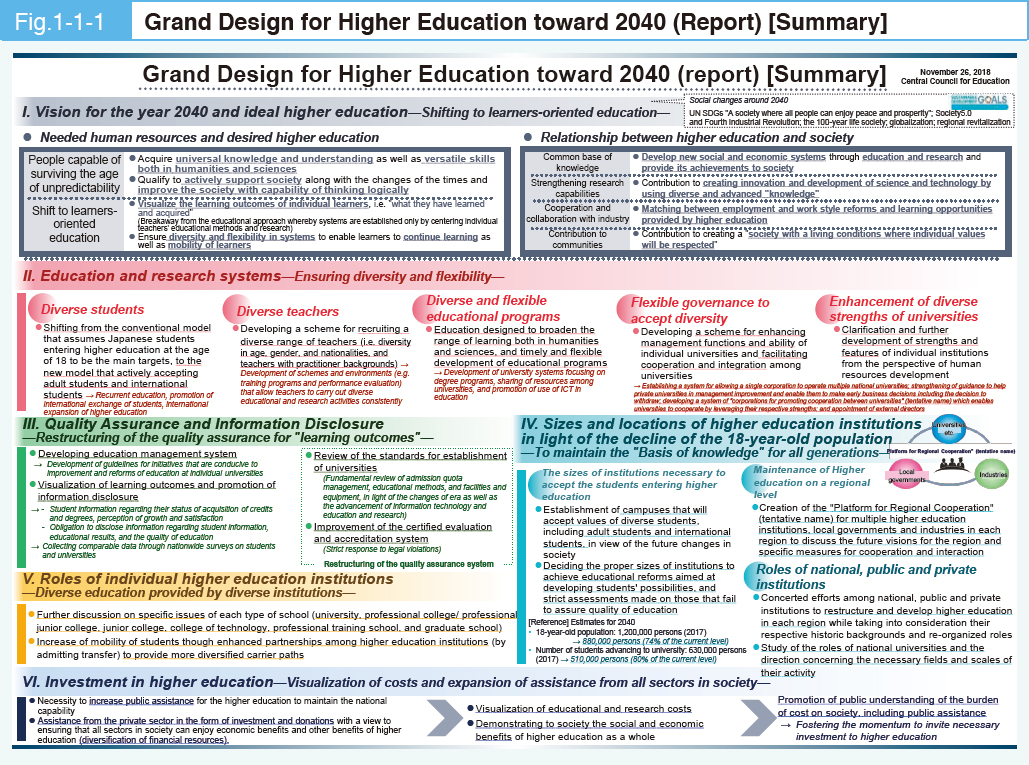
Vision for the year 2040 and ideal higher education ―Shifting to learners-oriented education―
Chapter I “Vision for the year 2040 and ideal higher education ―Shifting to learners-oriented education―” summarizes the human resources needed and ideal higher education in 2040 as well as the relationship between higher education and society based on the predictions around the key words: Sustainable Development Goals (SDGs) advocated by the United Nations, Society5.0, Fourth Industrial Revolution, the 100-year life society, globalization and regional revitalization.
What kind of human resources are desirable to support and lead society when we welcome the year 2040? With the advent of the age of unpredictability, it is important to acquire basic and universal knowledge and understanding including reading literacy and mathematical thinking and versatile skills both in humanities and sciences. According to the Report, it is necessary that such human resources will actively support and improve society in accordance with the changes of the times. In addition, the Report suggests that it is important to learn mathematics, data science, etc., as basic literacy both in humanities and sciences.
As “ideal higher education” for development of these human resources the report sets forth “Shift to learnersoriented education”. It recommends the shift from “what you taught” to “what they have learned and acquired” and the importance of visualizing the learning outcomes of individual learners and establishing a system that enables learners to continue learning.
Relationship between higher education and society with focus on 2040
As regards “relationship between higher education and society in 2040”, the Report mentions that higher education should develop new social and economic systems to address the challenges of the world through education and research and, by creating a virtuous cycle of providing achievements to society and obtaining its acknowledgement and support, ensure continuous development of educational functions to move from a “Common base of knowledge” to a “Center of knowledge and human resources”. It then presents the following three perspectives:
① Strengthening research capabilities
Diverse and advanced new “knowledge” significantly contributes to creating innovation and development of science and technology. Meet social needs by linking achievements of scientific research to creation of social/ economic values.
② Cooperation and collaboration with industry
To enable diverse students including adult students to learn from each other, it is essential to coordinate employment and work style reforms and learning opportunities provided by higher education
③ Contribution to communities
Create a “society with a living conditions where individual values will be respected” in the community the person desires to live in.
Specifics
Education and research systems ―Ensuring diversity and flexibility―
According to the Report, in order to help individuals maximize their potential and acquire the ability to survive in the age of AI and globalization, higher education needs to break away from uniform education based on the view of the education provider and become “a place to create new values by diverse human resources with diverse values”, which means “campuses that will accept values of diverse students”.
This section, under the keyword of “diversity and flexibility”, recommends specific measures to carry out initiatives from the perspectives of students, teachers, educational programs, governance and enhancement of strengths.
(1) Diverse students
According to the report it is necessary to shift from the conventional model that assumes Japanese students entering higher education at the age of 18 to be the main targets, to the new model that actively accepts adult students and international students through recurrent education, promotion of international exchange of students and international expansion of higher education.
(2) Diverse teachers
The report finds it necessary to develop a scheme for recruiting a diverse range of teachers (i.e. teachers with practitioner backgrounds for utilization of outside resources and diversity in age, gender, and nationalities for education research with diversity of perspectives) and create environments (e.g. training programs and performance evaluation) that allow teachers to further develop their abilities and carry out diverse educational and research activities consistently.
(3) Diverse and flexible educational programs
The report notes that there is a need for broader learning for students through the combination of expertise across disciplines and curricula both in humanities and sciences. It also finds it necessary to enable timely and flexible development of educational programs through university systems focusing on degree programs, share resources among universities, and promote use of ICT in education.
(4) Flexible governance to accept diversity
The report will introduce a system permitting a single national university corporation to operate multiple universities as a mechanism for facilitating the smooth collaboration and integration among universities in order for the universities to share effectively their human and material resources and, at the same time, to strengthen their education and research functions. The report will emphasize the necessity of introducing this “corporations for promoting cooperation between universities system” (tentative name), which will enable universities to cooperate by leveraging their respective strengths and will facilitate transfer programs by the recognition of undergraduate credit transfers and so on at private universities. The report also finds it necessary to promote appointment of external directors in order to enhance management functions and ability and ensure transparency of operation.
(5) Enhancement of diverse strengths of universities
he Report points out the importance of clarification and further development of strengths and features of individual higher education institutions for human resources development.
Quality Assurance and Information Disclosure ―Restructuring of the quality assurance for “learning outcomes”―
Higher education institutions need to improve education quality for the growth of learners for the period from admission to graduation and also after graduation.
Some universities are making efforts to improve quality assurance in education. However, there is a polarization between these universities and other universities that are not making sufficient improvement efforts. As a whole, their efforts are not sufficiently positively evaluated by society.
This chapter summarizes how to proceed with quality assurance and information disclosure for the restructuring of the quality assurance of “learning outcomes”.
A considerable part of this item is left to deliberation after the Report. Specific explanation is given in Section 3 “Future direction of reform”.
Sizes and locations of higher education institutions in light of the decline of the 18-year-old population — To maintain the “Basis of knowledge” for all generations
This chapter summarizes “The sizes of institutions necessary to accept the students entering higher education,” “Roles of national, public and private institutions” and “Maintenance of Higher education on a regional level.”
(1) The sizes of institutions necessary to accept the students entering higher education
For depiction of a future image it is important to correctly understand the current trend concerning entrance to higher education and specifically visualize estimation of future trends. For this purpose, the number of the students entering higher education in 2040 is estimated.
The number of the students entering higher education will decrease about 230,000 from current 970,000 to 740,000; of those the number of students advancing to university will decrease about 120,000 from about 630,000 to 510,000.
Based on this estimation, the report notes that individual higher education institutions should recognize the impossibility of maintaining their current size with the education system centering on 18-year-old Japanese new students, carry out educational reforms to develop students’ possibilities and decide the proper size for this purpose. On the other hand, the report expects expansion of the number of adults and international students from the perspective of diversity.
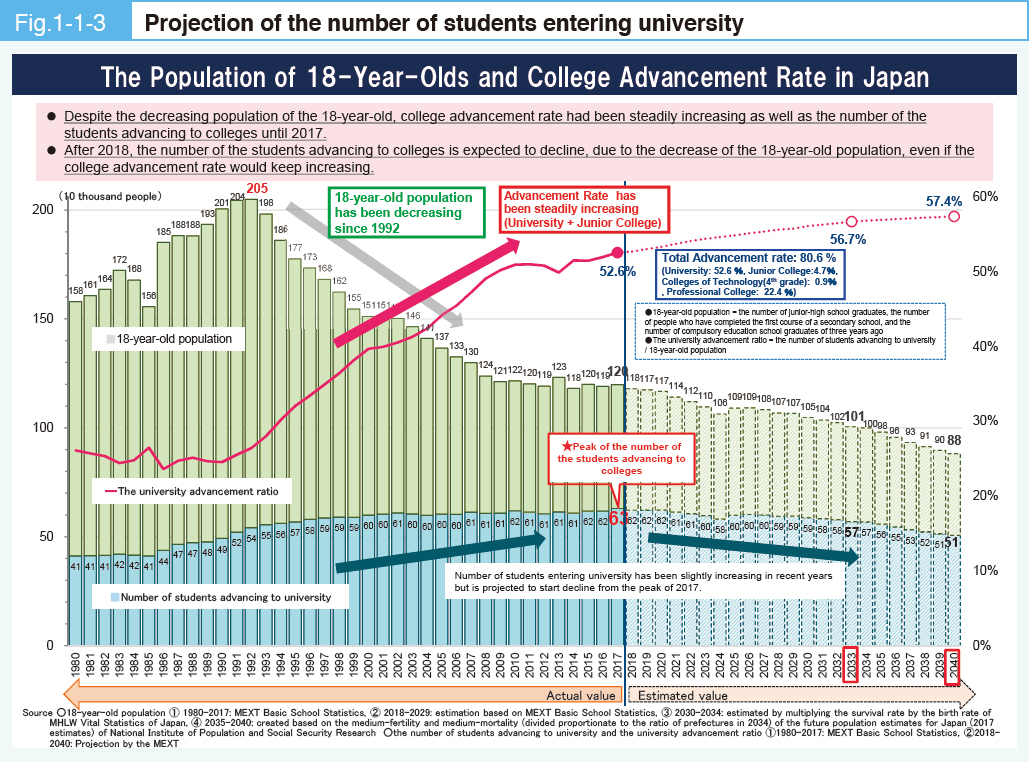
(2) Roles of national, public and private institutions
The report describes the roles of the parties that establish national, public and private schools as follows based on the development history of higher education.
(National universities)
They have roles to promote research and education that lead “knowledge creation” in Japan and the world, carry on and develop important academic disciplines and promote educational research that involves financial burden. At the same time they need to study the quota size based on the decline of the 18-year-old population, and also carry out reforms to clarify their role and expand their functions, which include the Human Resource Developent toward creation of Society 5.0 (focus on graduate school functions, conduct review toward a baccalaureate degree program covering across social and natural science sectors, etc.)
For this purpose, it is necessary for the central government to study the direction concerning the courses, fields and institutional scales for individual universities to fulfill their roles in undergraduate and graduate education, while holding discussions with national universities and paying attention to the strengths and features of individual universities and local conditions.
(Public universities)
Public universities have a central role in the higher education policy of local governments. It is necessary to study how they should fulfill their roles toward realization of equal educational opportunities, promotion of regional vitalization and solution of administrative challenges based on the situation of the higher education institutions of the various regions.
(Private universities)
On the premise of maintaining their diversity, private universities need to carry out reforms to strengthen their management foundation and support the core of Japan’s higher education, while further improving education and research based on their philosophies and considering the student-teacher ratio.
(3) Maintenance of Higher education on a regional level
In the future 20 years where depopulation will further increase its pace, it will be a major challenge to ensure high-quality education opportunities in each region. As changes in industrial form are expected, this challenge is not limited to the educational field but also closely related to the development of individual regions including the related industries. We may be in an age where it is not enough that the central government presents the future image of higher education, but it is also necessary for higher education institutions together with industries and local governments to discuss the grand design of regional higher education as their future vision.
To this end, the report finds it necessary to create the “Platform for Regional Cooperation (tentative name)” for discussion with industries and local governments on future vision, specific measures for cooperation and interaction and other matters; on the other hand, it is the role of the central government to collect various data comprehensively for the discussions and establish a system for cooperation and integration.
Roles of individual higher education institutions ― diverse education provided by diverse institutions ―
This chapter summarizes specific issues of each type of school (university, professional and vocational university (PVU)/ professional and vocational junior college (PVJC), junior college, college of technology, professional training college), and graduate school.
The report also mentions the need to increase the mobility of students through enhanced partnerships among higher education institutions (by admitting transfer) to provide more diversified carrier paths.
(Professional and vocational university/ professional and vocational junior college)
Established in FY2019, these colleges are a new type of higher education institution that provide education in close cooperation with industries to develop human resources who can lead professional services with advanced practical skills that are theoretically backed up and who can create new values in response to changes.
(Junior college)
Junior colleges are expected to play roles such as community contribution through recurrent education taking advantage of the short school years and easy access in the community. It is important to improve the quality as higher education institutions necessary for the communities. Toward 2040 it is necessary to reposition junior colleges as short-term higher education institutions in the university system.
(College of technology)
It is important to improve the education quality of colleges of technology by strengthening the Human Resource Developent who will lead new industries, advancing education in cooperation with universities and the internationalization of their education integrally with overseas deployment of the Japanese college of technology system.
(Professional training college)
The authorization system for “Professional Post-Secondary Course” that started in FY2014 requires assessment of school officials, information disclosure and other requirements. The report finds it necessary to require these efforts for quality assurance and improvement for all professional training colleges. For the future they are expected to play a major role in enhanced vocational education in University-Industry Collaboration, active acceptance of international students and recurrent education. It is important to improve their quality as higher education institutions necessary for their communities.
(Graduate school)
Graduate schools are expected to play a central role in development of excellent human resources who lead knowledge production and value creation in a knowledge-intensive society. However, there are indications of problems such as a gap between their curriculums and social needs, insufficient awareness of students’ academic and career paths and an increase in the number of excellent Japanese students who do not enroll in a doctor’s course. The report asks the central government to make it compulsory for graduate schools to formulate and disclose measures for the above three issues, consider legal positioning of universities’ efforts to present financial plans and start to encourage utilization of master’s degree graduates in companies and improvement of their working conditions.
Investment in higher education ― Visualization of costs and expansion of assistance from all sectors in society ―
Toward 2040 the population will decline in Japan as a whole, especially the ratio of the productive age population will decline. In this context, in order to support society and help people enjoy rich life, higher education is expected to develop human resources for the future by becoming a source of innovation, establishing themselves as knowledge bases of communities and maximizing the potential of each learner.
Higher education that can fulfill this role is a national capability. The Report calls for strengthening of the assistance from the private sector in the form of investment and donations, individual charges and other investments in higher education, while ensuring necessary public supports. Assuming these investments, it is important that the government encourages donation culture, and that universities, not wholly dependent on public support, diversify their financial resources by actively securing investment from private companies, local governments, individuals, etc.
The report also suggests the need to promote understanding of the social burden including public support through visualization of educational and research costs and demonstrating to society the social and economic benefits of higher education as a whole.
Future direction of reforms
Review of the quality assurance system
(1) “Quality Assurance” and “Information Disclosure” by universities
The Report states as follows: for quality assurance of education, it is primarily important that the university takes the initiative; it is necessary to make persistent efforts for improvement through systematic and organized university education based on three policies (diploma policy; curriculum policy, and; entrants selection policy) and check/evaluation of the results based on the concepts and criteria common to all courses conferring degrees. To this end, the Central Council for Education needs to discuss “guidelines for the management of teaching and learning” that exhaustively compiles ways for individual universities to improve their initiatives for management of teaching and learning and present the guidelines to all universities.
Furthermore, as universities are expected to be aware of outside opinions and expectations including communities and industries and proactively achieve accountability, it is important for them to disclose information on the quality of education including education outcomes of the university and efforts to improve management of teaching and learning. In addition to active disclosure by individual universities, the Central Council for Education should compare their information based on nationwide surveys on students and universities and publish the result as a list.
Universities that do not make earnest efforts for quality assurance or information disclosure will receive a harsh evaluation from society. As a result, they might have to withdraw from education.
(2) Improvement of the “quality assurance system” in Japan
Japan’s quality assurance system consists of a combination of approval of university establishment and various university evaluations of educational research activities after the establishment including evaluations (evaluation by organizations certified by the Minister of MEXT). Approval of establishment and accreditation are carried out based on the Standards for Establishment of Universities enacted in 1956. The Standards have been revised according to the changes in circumstances, but it is necessary to fundamentally review the current Standards in terms of admission quota management, educational methods, and maintaining facilities/improving facilities. In order that the accreditation contributes to more efficient, effective and substantial improvements, it is recommended to use other evaluations, review the examination period and introduce mandatory certification of the compliance with the Standards for Establishment of Universities.
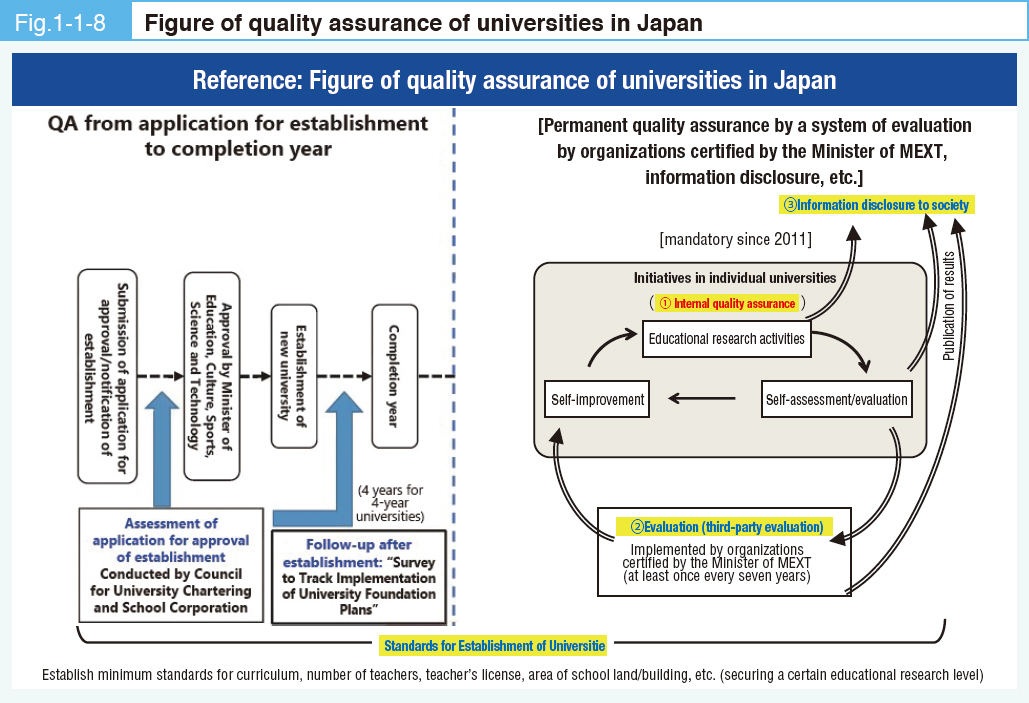
Cooperation and collaboration with industry
The report mentions that, while higher education institutions are working for quality assurance, industry is required to show the detailed image and skills of the human resources being sought during recruiting process, actively use visualized information of learning outcomes presented by the universities, and send students a message that they place emphasis on their learning outcomes in the university. For this purpose, higher education institutions and industries need to share understanding of the content of learning outcomes.
In addition, higher education institutions in cooperation and collaboration with industries need to actively support development of practical and specialized recurrent programs and learning at higher education institutions, and actively participate in the “Platform for Regional Cooperation” (tentative name).
Future examination subjects
The report summarizes future examination subjects including the review of the quality assurance system as follows. Based on the Report the MEXT will promote related measures including necessary law amendment.
Central Council for Education
・Review of the quality assurance system including standards for establishment
・Development of the guidelines for the management of teaching and learning, study on the modality of visualization of learning outcomes and information disclosure Central Government (MEXT)
・Advice to higher education institutions for setting up of the “Platform for Regional Cooperation” (tentative name), implementation of opinion exchange with local governments and development of “guidelines” on items to be discussed
・Framework of “corporations for promoting cooperation between universities” (tentative name) which is a system for cooperation across national, public and private universities, and for the content of the standards for approval and review of systems for promotion of cooperation
・Study of direction of the courses and fields and scales by which individual national universities will fulfill their roles, while paying attention to the strengths and features of individual universities and local conditions
・Systemic revision necessary for cooperation and integration among universities (a system for allowing a single corporation to operate multiple national universities; Smooth business transfer of individual departments, etc. by private universities)
・ Necessary systemic revision (recurrent education, promotion of international exchange of students, university systems focusing on degree programs, etc.) discussed by the Working group on Institutional and Educational reform (excluding fundamental review of the Standards for Establishment, development of the guidelines for the management of teaching and learning and other matters that were found to need further study)
Reference
About “Grand Design for Higher Education toward 2040 (Report)” (MEXT website)
http://www.mext.go.jp/b_menu/shingi/chukyo/chukyo0/toushin/1411360.htm
A university’s initiative for visualization of learning outcomes (Kochi University)
As its basic objective of education, Kochi University sets “train professionals with problemsolving ability through deepening of education based on ʻregional cooperationʼ on the basis of comprehensive general education”. To this end, since FY2016 the university has been working for quality assurance under the Acceleration Program for University Education Rebuilding (AP) of the MEXT. Three pillars of the initiative were: (1) change in the way of thinking by teachers and other personnel for education reform; (2) development of multifaceted evaluation indices based on a diploma policy, and; (3) verification of studentsʼ growth in cooperation with the communities and society.
The universityʼs initiatives under the program cover many fields. Initiatives for visualization of learning outcomes include: establishment of evaluation indices for “10 + 1 abilities” based on a diploma policy and development of an assessment tool for measurement, and; construction of an “e-portfolio” that is a tool to give individual students feedback on their credit status and performance distribution, etc.
Learning outcomes of individual students and education effectiveness of the university as a whole which are visualized through the initiatives are used to build a system of quality assurance of education in Kochi University.
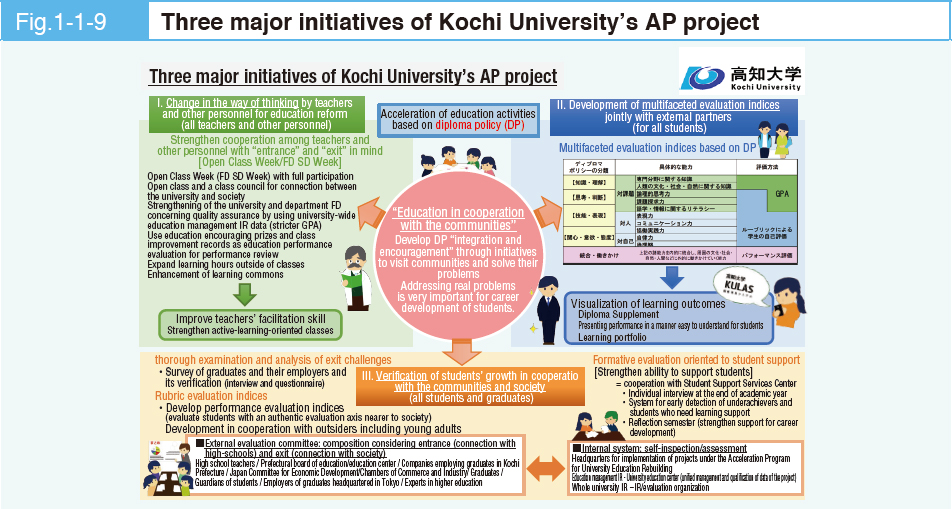
Student surveys
Amid the declining 18-year-old population, it is called into question more than ever what the students could learn through university education. However, there are opinions that it is not clear how individual universities worked for improvement of their education and how the efforts contributed to the development of the studentsʼ ability. The Report also states the need for sorting out of the situation by the central government through nationwide surveys on students and universities, which will help societyʼs understanding.
To this end, the MEXT plans a trial student survey in FY2019 to ask students across the country about education initiatives of their university and their evaluation of them as the first attempt of the central government to directly ask how students view their university.
It is expected that the educational ability seen from the perspective of the students can be used as evidence for improvement of the universitiesʼʼ initiatives and national policy making in the future.
This is the first time for the central government to implement this kind of student survey, but there are some cases implemented by private groups and others.
Case 1 Student Survey by the Universities Institutional Research Consortium
Every year “freshmen survey” and “upperclassmen survey (second to fourth graders)” of all member universities are carried out to find out how students perceive and evaluate their learning in university.
Survey items are mainly about studentsʼ learning behavior, study time, self-assessment of ability and satisfaction level. Because the survey is carried out by member universities using common survey items, you can find features of each university by comparing its survey result with the result of all other member universities.
Case 2 “Survey concerning learning conditions of university students” by the National Institute for Educational Policy Research
The survey has been carried out for students enrolled in universities, colleges and junior colleges across the country every two years since FY2014. The aim is to prepare basic data that can be used for policy making, which include support measures and system development necessary for promotion of the quality of education, through comprehensive understanding of learning conditions of university students.
Survey items include study hours/living hours, class subjects taken, credit earning and performance. The survey is implemented jointly with “survey of studentsʼ living” implemented by the Japan Student Services Organization.
Case 3 “JAPUC Student Life Survey” by JAPUC Committee on Student Affairs
The survey is carried out every four years for undergraduates enrolled in the member universities. The aim is to adequately understand studentsʼ living conditions, characteristics and changes of their needs and intentions, and use the results for study of challenges of university education and student support as well as for more finely tuned support for learning and living.
Survey items include satisfaction with the faculty/department, fulfilling student life, economic conditions, experience of studying abroad, career/employment, and abilities that they feel they have acquired. Changes over time are analyzed.
Initiatives regarding Platform for Regional Cooperation “Budding - Platform Maebashi”
Maebashi city is facing a challenge of depopulation. Especially, its productive age population (15 to 64-year-olds) declined by 22,000 people in 10 years from 2005 to 2015.
Its major factor is that the 15 to 24-year-old populationʼs moving out exceeds the same populationʼs moving in. Many young people tend not to stay in the city when they enter further education or find a job. Other major challenges are: the city and other organizations donʼt have concrete figures; and lack of an industry-academic-government cooperation system with participation of all universities in the city, which leads to insufficient use and sharing of resources.
To address this situation, six national, public and private universities in the city, the Maebashi Chamber of Commerce and Industry and the city signed a partnership agreement, established “Budding - Platform Maebashi” that is a council to gather wisdom from industries, government and universities, and are promoting strong partnership to solve the challenge of developing and retaining local human resources.
The goal of the platform is to solve complex local challenges (encourage young people to choose local schools/jobs, succeed local businesses) shared by industries, governments and education.
(Examples of goals pertaining to higher education)
・ The percentage of enrollees in the city at or above the 2018 level by FY2023 by making universities in Maebashi more attractive and by strengthening publicity.
・ The rate of employment in the city at or above the 2018 level by FY2023 by creating contact opportunities with attractive industries in the city.
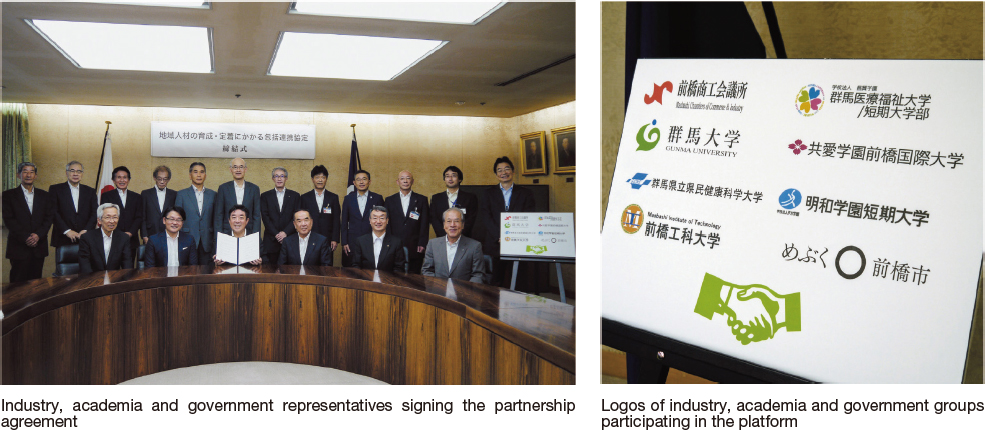
What is management of teaching and learning?
“Grand Design for Higher Education toward 2040 (Report)” compiled by the Central Council for Education in November 2018 upholds the “Shift to learner-oriented education”. It states the need for continued efforts for the shift from “what you taught” to diverse and flexible higher education centered on “what the learners have learned and acquired”.
Realization of the shift requires appropriate guarantee of the quality of the education provided by universities. For this purpose, each university needs to establish the administrative operation to achieve its educational purpose, namely, management of teaching and learning.
For establishment of the management of teaching and learning, individual universities need to provide systematic education to develop the ability of each student under the leadership of its president based on “three policies”: “diploma policy” that provides the ability of students upon whom degrees are conferred; “curriculum policy” that provides what education to provide for acquiring degrees and; “entrants selection policy” that establishes the desired abilities of students who receive the education. It is also necessary to check and evaluate the educationʼs outcome at all times and make persistent efforts to improve the quality of the university education and the quality of studentsʼ learning.
In this improvement process, it is also important that each university accurately understands the information on studentsʼ learning outcome and the education outcome of the university as a whole in order to use the information for review of its educational activities.
In order to support establishment of the management of teaching and learning at universities based on the recognition presented by the Grand Design Report, the “Special Committee on Management of Teaching and Learning” was set up under the Subdivision on Universities, Central Council for Education in November 2018. The committee has been developing arguments on “Guidelines for the management of teaching and learning” and other matters.
Analysis of social and economic costs in UK
In October 2017, Universities UK published THE ECONOMIC IMPACT OF UNIVERSITIES IN 2014-15)*1 The report aims to gain understanding of related parties and the public at large concerning the huge economic contribution of UK universities to the country so that they can gain long-term support. The report was created by research company Oxford Economics on consignment of Universities UK. Below we introduce the report using excerpts from the report, mostly from its summary.
Higher education in the UK has a major impact on the Gross Domestic Product (GDP) of the country. Universities operations alone contribute a Gross Value Added (GVA) of 46.8 billion pounds (7,020 billion yen) to GDP. This is 2.6% of all economic activities of UK.
When combined with spending by international students and their visitors, the impact rises to 52.9 billion pounds (7,935 billion yen) which is about two times of the total GVA of the city of Birmingham in 2015.

Universitiesʼ activities including research, education and provision of various services for students and communities generated Gross Output at 33.2 billion pounds (4,980 billion yen) in 2014-2015. This is higher than the annual gross output of the legal activities and advertising/marketing industries of UK.

Reprinted by courtesy of Science Portal*2
Reform of Higher Education and Research (Shibayama Initiative)
In February 1, 2019, “Reform of Higher Education and Research (Shibayama Initiative)” was announced. The initiative is a policy package to integrally implement “Ensuring access to higher education institutions,” “Improving and ensuring quality,” “Boosting research capability” and “Strengthening education-research base and governance” of higher education/research institutions. By carrying out this initiative on a top-priority basis, MEXT will promote the formation of “groups of top universities that will be a leading force in the world” and “clusters of universities that will be leading forces in their regions and specialist fields”, and the activities of “researchers at the frontlines of their fields” and “students who will lead the next generation.”
Reform of Higher Education and Research (Shibayama Initiative) consists of the following four pillars:
① “Ensuring access to higher education institutions” for young people with the desire to study
② “Improving and ensuring the quality of education” considering diversity and needs of society
③ “Boosting research capability” of National Research and Development Agencies, and
④ “Strengthening education-research base and governance” that form the basis of the reforms.
These are closely related to each other.
Shibayama Initiative will accelerate the four reforms through “generous support” and “rigorous evaluation and assessment” in accordance with the efforts and outcomes of the higher education and research institutions.
“Bill regarding Assistance for Study at Universities etc.” and “Bill for partial amendment to the School Education Law” were submitted at the 198th regular session of the Diet. The acts were enacted in May of this year. MEXT will integrally carry out the reforms upheld by the initiative on a top-priority basis.
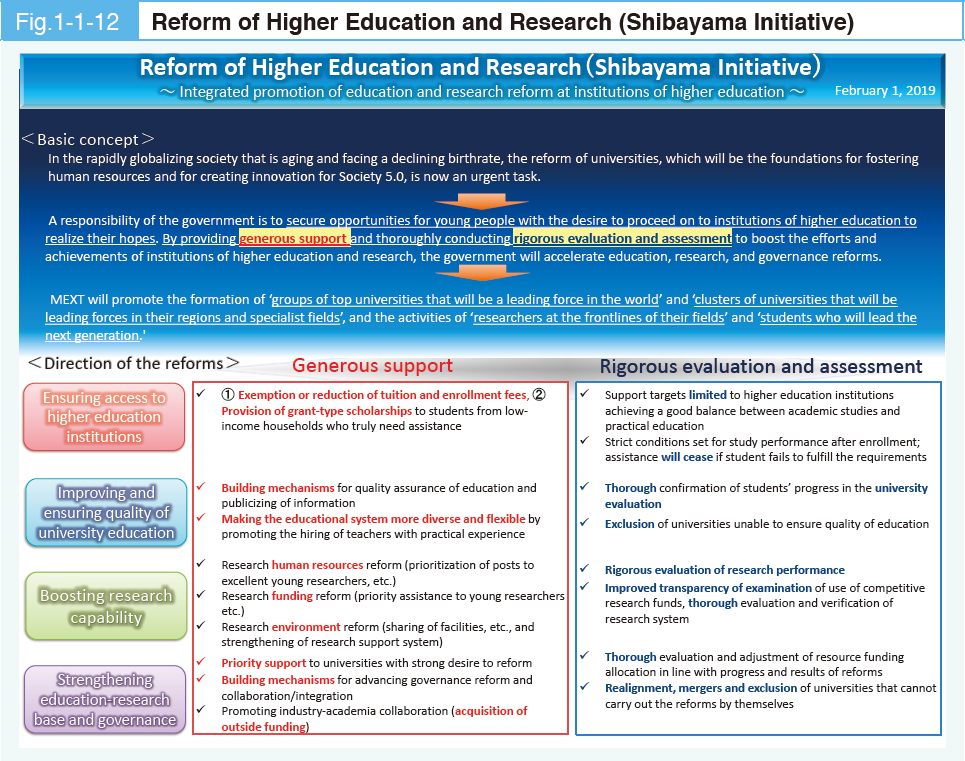
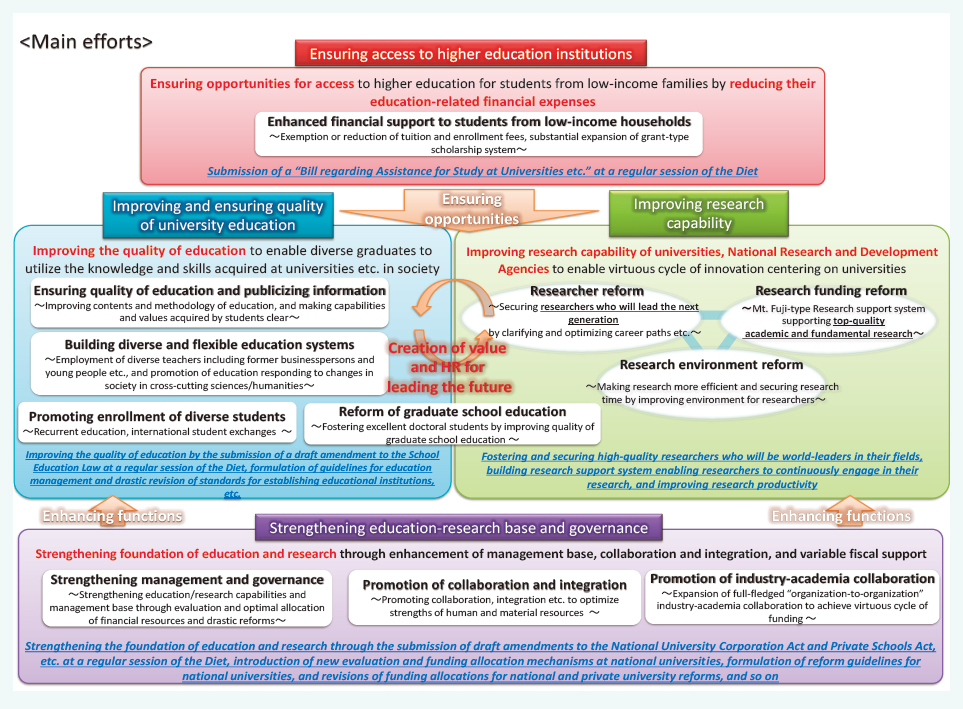
お問合せ先
Education Policy Bureau Policy Division